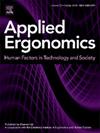Effects of the use of a shift schedule evaluation tool with ergonomic recommendations on employee wellbeing - a quasi-experiment in the Finnish healthcare sector
IF 3.4
2区 工程技术
Q2 ENGINEERING, INDUSTRIAL
引用次数: 0
Abstract
We investigated the effects of a shift schedule evaluation tool with ergonomics recommendations on employee wellbeing. The study sample was from the Finnish Public Sector study (n = 7002 employees). The shift planners' use of the shift schedule evaluation tool was linked to employees' self-reported wellbeing outcomes. Inverse probability weights, reflecting the likelihood of the evaluation tool's use by the shift planner, were calculated using multilevel mixed-effects logistic regression for each participant and logistic regression for each ward. Wards using the tool (intervention group) were compared to those not using it (control group) with a generalized linear model. No association was found between the tool's use and wellbeing at the ward level. In the individual level, lower psychological distress was found in the intervention group (Risk ratio 0.92, 95 % Confidence interval 0.85−0.99). More rigorous use of the tool may be necessary to achieve significant benefits for wellbeing.
使用轮班时间表评估工具与人体工程学建议对员工福利的影响-芬兰医疗保健部门的准实验
我们调查了轮班时间表评估工具与人体工程学建议对员工福利的影响。研究样本来自芬兰公共部门研究(n = 7002名雇员)。轮班计划者对轮班时间表评估工具的使用与员工自我报告的健康结果有关。反概率权重反映了轮班计划者使用评估工具的可能性,对每个参与者和每个病房使用多级混合效应逻辑回归计算。使用该工具的病房(干预组)与未使用该工具的病房(对照组)采用广义线性模型进行比较。在病房层面上,没有发现工具的使用与幸福感之间的联系。在个体水平上,干预组的心理困扰程度较低(风险比0.92,95%可信区间0.85 ~ 0.99)。更严格地使用该工具可能是必要的,以实现对健康的重大好处。
本文章由计算机程序翻译,如有差异,请以英文原文为准。
求助全文
约1分钟内获得全文
求助全文
来源期刊

Applied Ergonomics
工程技术-工程:工业
CiteScore
7.50
自引率
9.40%
发文量
248
审稿时长
53 days
期刊介绍:
Applied Ergonomics is aimed at ergonomists and all those interested in applying ergonomics/human factors in the design, planning and management of technical and social systems at work or leisure. Readership is truly international with subscribers in over 50 countries. Professionals for whom Applied Ergonomics is of interest include: ergonomists, designers, industrial engineers, health and safety specialists, systems engineers, design engineers, organizational psychologists, occupational health specialists and human-computer interaction specialists.
 求助内容:
求助内容: 应助结果提醒方式:
应助结果提醒方式:


